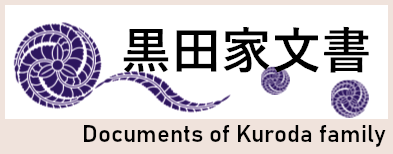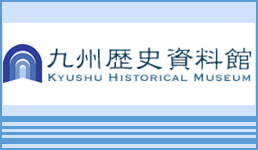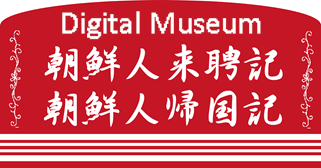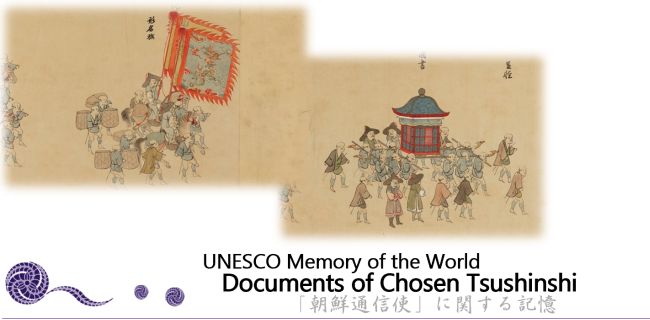
Documents of Kuroda family – “Chosenjin Raiheiki (Record of Korean's Visit)” “Chosenjin
Kikokuki (Record of Korean’s Return)”
On October 31, 2017, “Documents on Joseon Tongsinsa/Chosen Tsushinshi (Korean Embassies): The History of
Peace Building and Cultural Exchanges between Korea and Japan from the 17th to 19th Century” was registered
for the UNESCO Memory of the World Register. The nomination was submitted jointly by the Busan Cultural
Foundation (Republic of Korea) and The Liaison Council of All Places Associated with Chosen Tsushinshi
(Japan). The Documents include diplomatic documents, travel records, and cultural exchanges related to 12
diplomatic missions dispatched from Korea to Japan between 1607 and 1811 at the request of Japan’s Shogunate
government. The total number of materials is 333, of which 209 are in Japan.
This website shows and introduces “Chosenjin Raiheiki (Record of Korean’s Visit),” consisting of 11 books,
and “Chosenjin Kikokuki (Record of Korean’s Return)”, consisting of 4 books, which are included in the
documents registered for the Memory of the World Register. These books belong to the Documents of Kuroda
family recorded by the feudal domain of Fukuoka. “Chosenjin Raiheiki (Record of Korean’s Visit)” and
“Chosenjin Kikokuki (Record of Korean's Return)” are the records about how the Fukuoka Domain handled the 11th
Chosen Tsushinshi (Korean Embassies) who came to Japan in 1764, during the Edo period. These are currently
owned by the Kyushu Historical Museum.

1. What are the Chosen Tsushinshi ?
The Chosen Tsushinshi (朝鮮通信使), called “Joseon Tongsinsa:” (朝鮮通信使)” in Korean, were diplomatic embassies sent
by Korea to Japan throughout the Edo period. “Chosen/Joseon” means “Korea” and “Tsushinshi/Tongsinsa” means
“embassies.” Cross-cultural exchanges through Chosen Tsushinshi symbolized peace, good-will, and friendship
based on mutual respect between Japan and Korea.
History of the Chosen Tsushinshi
The history of this diplomatic system was reviewed and stipulated by Korea in 1802. According to this system
of diplomacy, the Tsushinshi/embassies had to meet the following conditions:
1) They had to be sent by the King of Joseon to the Shogun/General of Japan to express congratulations,
condolences, or resolve urgent matters.
2) They had to be organized by Sanshi(three envoys proper: seishi(chief envoy), fukushi(vice envoy),
jujikan(overseer)) or central officials of lower rank.
3) They had to carry the King's writings, gifts, and so on.
During the Muromachi period, 61 messengers claimed to be royal ambassadors. However, only 6 were admitted as
Tsushinsi between 1413 and 1479.
During the Toyotomi administration, the Tsushinsi were sent twice, in 1590 and 1596, but both ended in vain.
Although Hideyoshi Toyotomi's invasion of Korea ended with his death, the war devastated Korea. Ieyasu
Tokugawa, who was the Shogun after Hideyoshi and who did not dispatch invading troops, restored diplomatic
relations with Korea after negotiations with Samyeong Daesa Yujeong who was representative of the Korea
side.
Initially, the main purposes of Korea were to promote peace with Japan, learn about Japanese politics, and
repatriate Korean POWs. However, due to pressure from the hegemony struggle between the Mina and the Qing in
China, Korea sought even deeper friendship with Japan. The Japanese Edo Shogunate also tried to control the
Daimyo, powerful Japanese feudal lords, by using the dignity brought by international amity and ceremony with
Korea as incentive.
The Edo Shogunate regarded visits of the Chosen Tsushinshi as important and grand ceremonies. The
relationship between Korea and Japan became more intimate, and the role of the Tsushinshi changed to that of
embassies mainly celebrating the ascension of a new Shogun or other important events. A letter from the King
of Joseon was also exchanged with a reply of the Shogun on these visits.
From 1607 to 1811, the Chosen Tsushinshi visited Japan twelve times. Most of these visits were to Edo with
two exceptions. The second visit was to Fushimi in Kyoto and the twelfth was to Tsushima. On the fourth,
fifth, and sixth visits the embassies also visited Nikko.
The Tsushinshi were large embassy groups of 400 to 500 people and included painters, medical staff,
translators, musicians, and the Sanshi. They departed from Hanseong, the capital of Joseon (now Seoul), and
traveled about 3,000 km to and from Edo. Missions typically lasted more than six months. During their travels,
the Tsushinshi interacted with many cultured people through writing and poetry exchanges. Their fleets and
parades were enthusiastically greeted by the masses as well. Their journeys had a tremendous impact on each
social layer of Japan.
2. The Hospitality of the Fukuoka Domain
The Edo Shogunate welcomed the Chosen Tsushinshi at great expense and ordered Daimyos to treat them with the
utmost respect. Powerful Domain, similar to modern prefectures, were required to host the Tsushinshi at their
own expense. Maintenance of roads and bridges, accommodation and meals, transportation of numerous gifts and
luggage including horses and hawks, and so on were all organized and financed by the Daimyos. Despite the
heavy burden of hosting, Daimyos competed to give embassies their best hospitality to show loyalty to the
Shogunate.
The Fukuoka Domain welcomed embassies at Ainoshima, an island about 8km off the coast of Shingu. This small
island of 300-400 inhabitants became the gathering point for about 2000 people to welcome and prepare for the
embassies. It was a daunting task. The mobilization of people was enormous and included preparatory and
cleaning personnel. Inns were newly built for each visit and care and detail went into choosing tableware and
other furnishings. In addition to preparing fires and cooking food, it was sometimes necessary to build wharfs
for incoming ships and dig wells for water. If the weather was good, embassies would stay for just a day then
travel to the next destination such as Shimonoseki or Katsumoto Iki. Otherwise, embassies stayed for much
longer, increasing the need for food and other supplies.
The Tsushinshi stayed for eight days during the 3rd and 6th diplomatic missions in 1624 and 1655,
respectively. They stayed for 18 days on the ninth visit in 1719. During the eleventh visit in 1764, the
Tsushinshi stayed for 23 days from December 3 to December 26. The host had to treat not only the more than 400
embassies, but also the Tsushima Domain officials who accompanied and guarded the embassies throughout their
itinerary. The actual difficulties in getting and transporting foods for the long stays were recorded in
detail in the documents about Tsushinshi. The 1764 diplomatic mission was the last time that the Tsushinshi
traveled during the Edo period at such exorbitant costs. Due to the financial deficit of both Japan and Korea,
the 12th Chosen Tsushinsi was not held until 1811 and was hosted at Tsushima. Shortly after the Edo Shogunate
collapsed. During this suspension, the Chosen Tsushinshi ended.
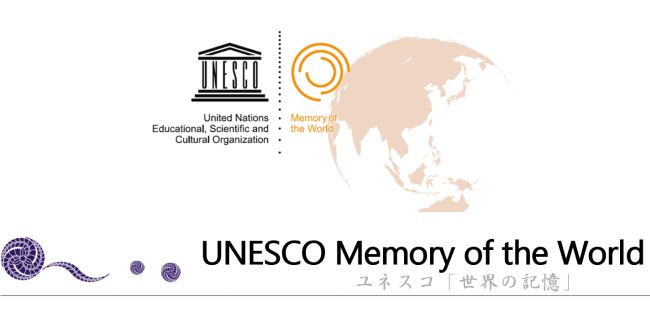
The Memory of the World is a project UNESCO started in 1992 to protect and promote the world’s important
documentary heritage. The review is conducted once every two years, and nominations are limited to two per
country.
The objectives of the project are:
1. To facilitate the preservation of the world's documentary heritage by the most appropriate techniques.
2. To promote universal access to documentary heritage.
3. To increase worldwide awareness of the existence and significance of documentary heritage.
The records include handwritten manuscripts, books, newspapers, posters, drawings, maps, music, films,
photographs, etc. As of October 2017, 427 items are registered including the Declaration of Human Rights
(France, 2003), Goethe's literary works, diaries, and letters (Germany, 2009), the oldest Quran in the world
(Uzbekistan, 1997), Rigveda, the oldest of the ancient Indian scriptures of the Vedas (India, 2007), and so
on.
Registered Heritage from Japan
• “Sakubei Yamamoto Collection” – Registered May 2011
• “Midokanpakuki” and “Materials Related to the Keicho-era Mission to Europe Japan and Spain” – Registered
June 2013
• “Return to Maizuru Port” and “Archives of Tōji temple contained in one-hundred boxes” – Registered October
2015
• “Three Cherished Stelae of Ancient Kozuke” and “Documents on Chosen Tsushinshi” – Registered October
2017
Ministry of Education, Culture, Sports, Science and Technology (MEXT) website
https://www.mext.go.jp/unesco/006/1373633.htm
The Liaison Council of All Places Associated with Chosen Tsushinshi
https://enchiren.com/
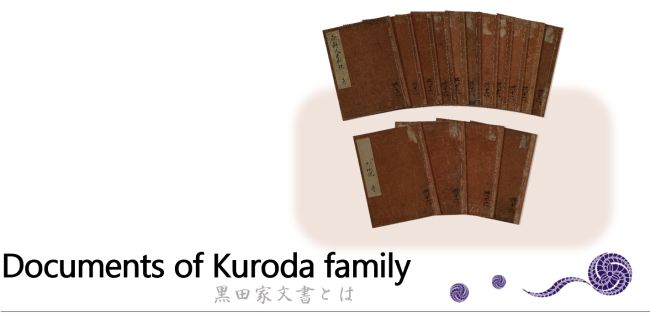
1. What is the Documents of Kuroda family?
The Documents of Kuroda family are records of the Fukuoka feudal government beginning from the middle of Edo
period. These records have been preserved by the Kuroda family started by Kuroda Clan, a feudal lord of
Fukuoka. These records include a total of 597 items and 1016 materials. After the abolition of the Domain
border system during the Meiji era, most of these documents were moved to Kuroda’s residence in Tokyo and to
Kuroda’s villa and the Terumo Shrine in Fukuoka.
In 1945, during World War II, all the records were burned except for those stored in Tokyo. After the war,
the Documents of Kuroda family was kept at Mitsui Warehouse in Tokyo. Around 1963, the late Yutaka Chikushi
negotiated with the Kuroda family about Residter handling. In 1964 Nagamichi Kuroda, who was Kuroda family
head at that time, donated a collection of items to Fukuoka that belonged to Jintaro Fujii, Kuroda's house
steward. The collection included 40 items and 470 books. In 1974, the Kuroda family donated additional
documents. In 1995, Mr. Toshio Nakahara donated documents, which he purchased as old books, to Fukuoka
Prefectural Library where they were added to the Documents of Kuroda family.
Currently, about 3,000 materials from the Kuroda family, including unsorted ones, are preserved at the
Fukuoka City Museum. About 1000 materials were donated to the Fukuoka Art Museum in 1979 and later transferred
to the City Museum when it opened in 1990. The other 1000 materials were recently donated by the Kuroda
family. Chikushi Jogakuen, a high school in Fukuoka, also stores 296 of the Documents of Kuroda family
purchased from an antiquarian bookstores in Tokyo.
In 2018, the Documents of Kuroda family stored at the Fukuoka Prefectural Library was transferred to the
Kyushu Historical Museum following the registration of Documents on Chosen Tsushinshi in UNESCO’s Memory of
the World Register in 2017. Fifteen books from the Documents of Kuroda family documenting the 11th Chosen
Tsushinshi visit were included in the documents registered. As a result, these 15 books were repaired as a
project by the Fukuoka Prefectural Library.
2. The Records of the Documents of Kuroda family on the Chosen Tsushinshi
The Chosen Tsushinshi were dispatched a total of 12 times during the Edo period from 1607 to 1811. Fifty
books of the Documents of Kuroda family documented the 7th diplomatic journey in 1682, the 8th in 1711, the
9th in 1719, the 10th in 1748, and the 11th in 1764. Only about one third of the original records remain. Many
are thought to have been burned during World War II. The Documents how the Fukuoka Domain received, delivered,
served, and guarded the party of Chosen Tsushinsi after arriving at Ainoshima from Busan via Iki and
Tsushima.
This website introduces documents about the Tshushinshi which visited Japan in 1764 to celebrate the
inauguration of the 10th Shogun, Ieharu, of the Edo Shogunate. Documents from 1763 detailing the year of
preparation before the ceremony are also included.
Usage Guide/References
-----------------------------------------------------------------------
【Usage Guide】
・ This homepage introduces the Documents of Kuroda family including “Chosenjin Raiheiki (Record of Korean’s
Visit)”, consisting of 11 books, and “Chosenjin Kikokuki (Record of Korean’s Return)”, consisting of 4 books,
as part of the Memory of the World Register of UNESCO, and includes photos and reprints of the whole
documents.
・ The reprinted text was proofread based on the original document referring to “The Records of the Fukuoka
Domain on the Chosen Tsushinshi 8, 11, 13”, Fukuoka Local History Research Society, 1999-2000, edited by the
Ancient Documents Reading Party of Fukuoka Local History Research Society.
・ In the “The Records of the Fukuoka Domain on the Chosen Tsushinshi 8, 11, 13”, the letters such as 候, 等, 并,
々 were written with the original font but corrected to the typed letters. In addition, the abolished hiragana
letters, such as 候、等、并、々 were remained as kanji and katakana letters, but ゟ was corrected to “より(yori)”.
・ In the original document, there were inserted hand written notes in black and in red in small spaces between
lines, but it was difficult to arrange it in the same format, so they were located at the end of each page
indicated in the photos.
・ "The Records of the Fukuoka Domain on the Chosen Tsushinshi 8, 11, 13" consists each paragraph regardless of
the line breaks in the original document. However, on this website, the line breaks and arrangement of the
original document were maintained as much as possible.
・Except for the above, it was followed as the reprint of " The Records of the Fukuoka Domain on the Chosen
Tsushinshi 8, 11, 13".
・The reprinted text was proofread and checked with the original document by Ryugo Ishibashi, Kazuyo Shibayama,
Kumiko Tokisato, Masaki Morohara and Takashi Yokoyama.
・The process of donating the Documents of Kuroda family to the Fukuoka prefecture from the Kuroda family was
informed by the Local History Section of Fukuoka Prefectural Library, which used to hold the documents.
・ For English and Korean translations, they were proofread by Mr. Morohara and Mr. Yokoyama for English, and
Ms. Kim Eun-Jung for Korean. Ms. Kim is the international coordinator of Kyushu National Museum.
・ Photos of the “Chosenjin Raiheiki” and “Chosenjin Kikokuki” posted on the website are owned by the Fukuoka
Prefectural Library and the Kyushu History Museum.
* If you have any requests for publication / provision, please apply to the Kyushu History Museum (Click here for information about the
procedures).
・ Photos posted on the other websites were provided by the Iwakuni Chokokan, Kyushu National Museum, and
Shingu Town Board of Education, except for those in the Kyushu History Museum.
・ The homepage was laid out and the commentary was written by Yoshiji Sakai, curator of the Kyushu Historical
Museum.
【References】
Wonsik Lee, Astushiro Ohata, Gisu Shin, Kazuyo Tashiro, Takeo Tanaka, Hiroshi Nakao, Hiroshi Yoshida, and
Jinhee Lee, “The Chosen Tsushinshi and Japanese”, Gakusei-sha, 1992
Satoshi Ikeuchi, "The World of Killing the Tojin: Korean Recognition of Early Modern People", Rinkawa Shoten,
1999
Edited and published by Kyoto Culture Museum and Kyoto Shimbun, “21st Century Special Exhibition: Kokoro no
Koryu - The Chosen Tsushinshi: Messages from the Edo Period to the 21st Century”, 2001
West Japan Cultural Association, “Fukuoka Prefectural History, Fukuoka Domain (1)”, Fukuoka Prefecture,
1998
Edited and published by Fukuoka City Museum, “The Documents of Kuroda Family (1)”, 1999
Edited and published by the Ancient Documents Reading Party of Fukuoka Local History Research Society,” The
Records of the Fukuoka Domain on the Chosen Tsushinshi (1)”, 1993
Edited and published by the Ancient Documents Reading Party of Fukuoka Local History Research Society,” The
Records of the Fukuoka Domain on the Chosen Tsushinshi (2)”, 1994
Edited and published by the Ancient Documents Reading Party of Fukuoka Local History Research Society,” The
Records of the Fukuoka Domain on the Chosen Tsushinshi (8)”, 1999
Edited and published by the Ancient Documents Reading Party of Fukuoka Local History Research Society,” The
Records of the Fukuoka Domain on the Chosen Tsushinshi (11)”, 2000
Edited and published by the Ancient Documents Reading Party of Fukuoka Local History Research Society,” The
Records of the Fukuoka Domain on the Chosen Tsushinshi (13)”, 2000
